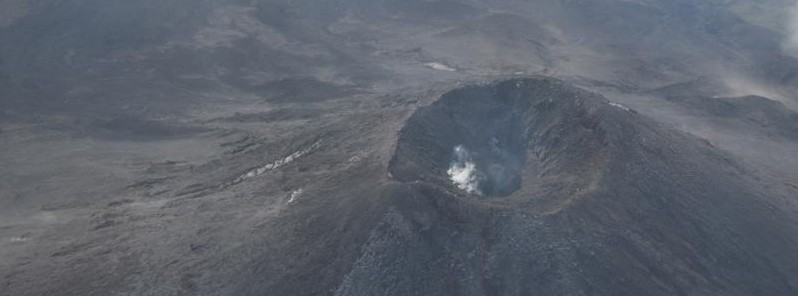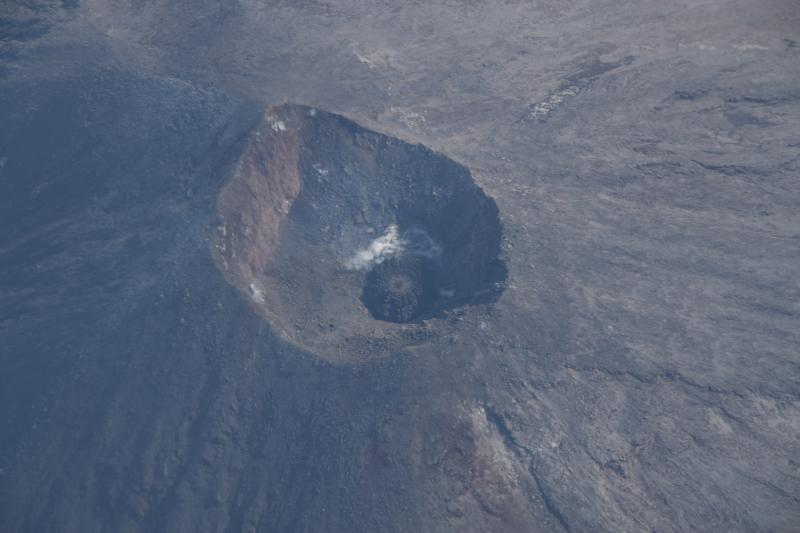Lava effusion in the summit crater of Cleveland volcano, Alaska

The eruption of Cleveland volcano and slow growth of a small lava dome in the summit crater of the volcano continues, the Alaska Volcano Observatory reported at 20:00 UTC on Friday, October 6, 2017.
Lava effusion in the summit crater was first noted in satellite data from September 30, forming a low-relief "pancake-like" dome that covered an area of about 4 200 m2 (45 208 ft2) by October 1.
Friday's low-resolution satellite data show highly elevated surface temperatures suggesting that slow growth of the lava dome continues. Lava effusion is typically confined to the summit crater at Cleveland, with the last significant lava flow (that extended to the ocean) occurring in 2001.
The lava domes that have been erupted since 2001 have all been destroyed by explosive activity within weeks to months after lava effusion. These explosions typically produce relatively small volcanic ash clouds that dissipate within hours, however more significant ash emissions have occurred.
There is no way to predict how long this lava dome will grow, or when it might be destroyed by an explosion. No significant activity related to lava effusion was observed in seismic data (from the limited network on Cleveland) and no explosive activity was detected in infrasound data over the past week.

Lava dome grows in the summit crater of Cleveland volcano, Alaska – August 17, 2017. Credit: Janet Schaefer, AVO/ADGGS
On Saturday, October 7, AVO reported that unrest continues at the volcano but it is unclear whether lava effusion continues or has paused. Satellite and web camera observations have been obscured by clouds over the past day. No significant activity related to lava effusion observed in seismic data (from the limited network on Cleveland) and no explosive activity detected in infrasound data over the past day.
Cleveland's current Aviation Color Code is Orange and Volcano Alert Level Watch.
This volcano is monitored with a limited real-time seismic network, which inhibits AVO's ability to detect precursory unrest that may lead to an explosive eruption. Rapid detection of an ash-producing eruption may be possible using a combination of seismic, infrasound, lightning, and satellite data.
Cleveland volcano forms the western portion of Chuginadak Island, a remote and uninhabited island in the east central Aleutians. The volcano is located about 75 km (45 miles) west of the community of Nikolski, and 1 500 km (940 miles) southwest of Anchorage. The most recent significant period of eruption began in February 2001 and produced 3 explosive events that generated ash clouds as high as 11.8 km (39 000 feet) above sea level.
The 2001 eruption also produced a lava flow and hot avalanche that reached the sea. Since then, Cleveland has been intermittently active producing small lava flows, often followed by explosions that generate small ash clouds generally below 6 km (20 000 feet) above sea level. These explosions also launch debris onto the slopes of the cone producing hot pyroclastic avalanches and lahars that sometimes reach the coastline.
Geological summary
Beautifully symmetrical Mount Cleveland stratovolcano is situated at the western end of the uninhabited, dumbbell-shaped Chuginadak Island. It lies SE across Carlisle Pass strait from Carlisle volcano and NE across Chuginadak Pass strait from Herbert volcano.
Cleveland is joined to the rest of Chuginadak Island by a low isthmus. The 1730-m-high (5 675 feet) Mount Cleveland is the highest of the Islands of the Four Mountains group and is one of the most active of the Aleutian Islands. The native name for Mount Cleveland, Chuginadak, refers to the Aleut goddess of fire, who was thought to reside on the volcano.
Numerous large lava flows descend the steep-sided flanks. It is possible that some 18th-to-19th century eruptions attributed to Carlisle should be ascribed to Cleveland (Miller et al., 1998).
In 1944 Cleveland produced the only known fatality from an Aleutian eruption. Recent eruptions have been characterized by short-lived explosive ash emissions, at times accompanied by lava fountaining and lava flows down the flanks. (GVP)
Featured image: Lava dome grows in the summit crater of Cleveland volcano, Alaska – August 17, 2017. Credit: Janet Schaefer, AVO/ADGGS

Commenting rules and guidelines
We value the thoughts and opinions of our readers and welcome healthy discussions on our website. In order to maintain a respectful and positive community, we ask that all commenters follow these rules:
We reserve the right to remove any comments that violate these rules. By commenting on our website, you agree to abide by these guidelines. Thank you for helping to create a positive and welcoming environment for all.